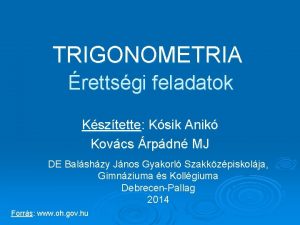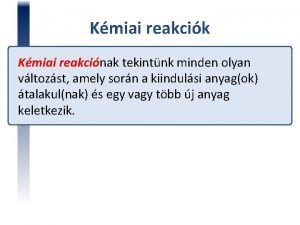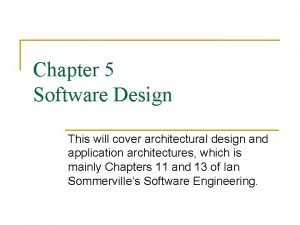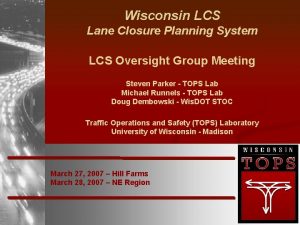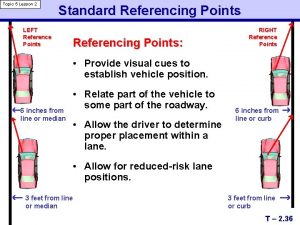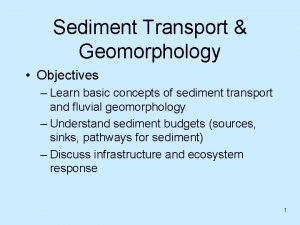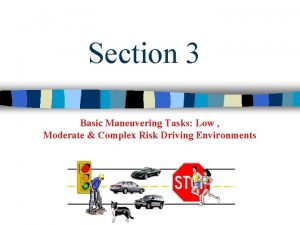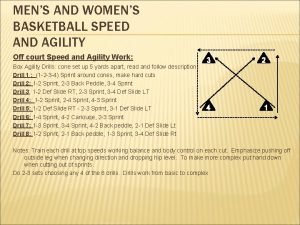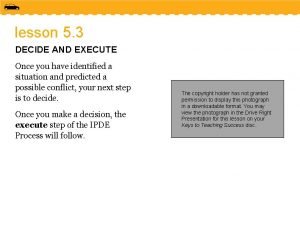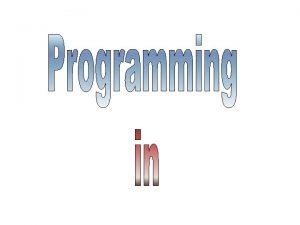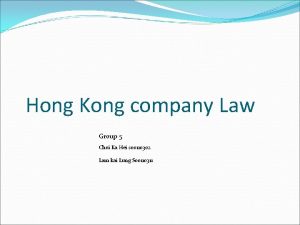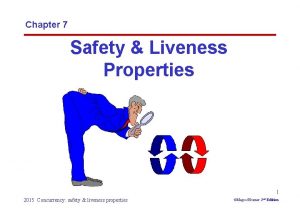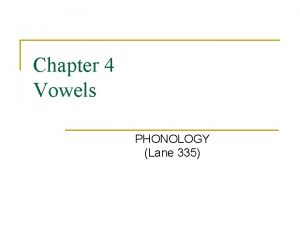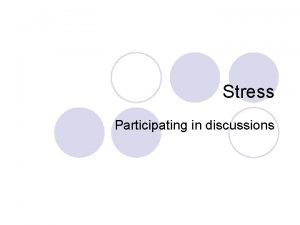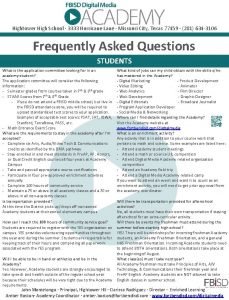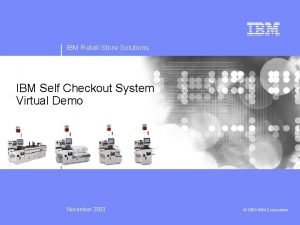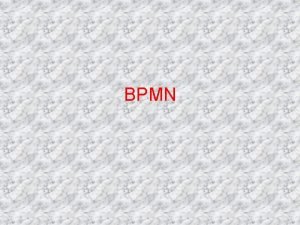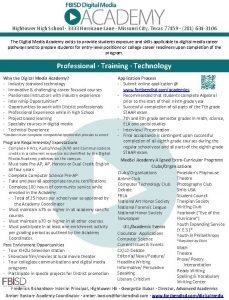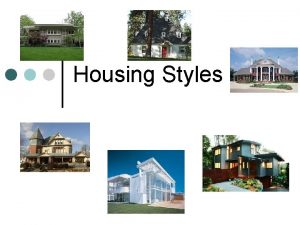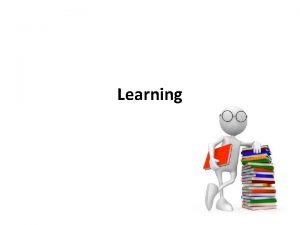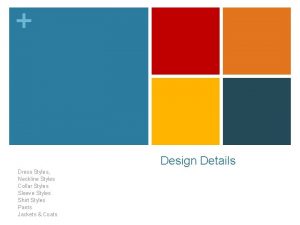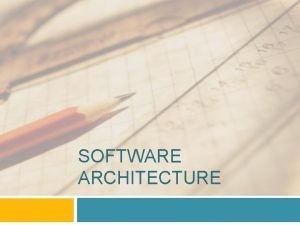Software Architecture Styles Hany H Ammar Professor LANE



































































































- Slides: 99

ﺑﺴﻢ ﺍﻟﻠﻪ ﺍﻟﺮﺣﻤﻦ ﺍﻟﺮﺣﻴﻢ ﻭﺍﻟﺼﻼﺓ ﻭﺍﻟﺴﻼﻡ ﻋﻠﻰ ﺭﺳﻮﻝ ﺍﻟﻠﻪ ، ﺍﻟﺤﻤﺪ ﻟﻠﻪ Software Architecture Styles Hany H. Ammar, Professor, LANE Department of Computer Science and Electrical Engineering West Virginia University, Morgantown, West Virginia, USA, and Visiting Professor, Faculty of Computers and Information, Cairo University, Cairo, Egypt Modeling and Documenting Software Architectures 1

OUTLINE Introduction • Software Architecture Styles • Independent Components • Virtual Machines • Data Flow • Data-Centered • Call-and return • SW Systems Mix of Architecture Styles • Other Important Styles • Modeling and Documenting Software Architectures 2

Introduction Recall the definition of Styles • An architectural style is a coordinated set of architectural constraints that restricts the roles/features of architectural elements and the allowed relationships among those elements within any architecture that conforms to that style.

Introduction What does it give us? • An architectural style describes a certain codification of elements and their arrangements. • Conversely, an architectural style constrains both the elements and their interrelationships. • It specifies components and connectors types

Introduction Example Component Types

Ex: Con nect or Type s

Examples of Popular Architecture Styles

Families of Architecture Styles • There is a number of families of styles that has been defined and used in many software systems Notable examples are: 1. Independent Components: Event-based Architectures 2. Virtual Machines 3. Data Flow: Pipes and Filters 4. Data-Centered Systems 5. Call-and Return Architectures Modeling and Documenting Software Architectures 8

OUTLINE • Introduction • Software Architecture Styles • Independent Components • Virtual Machines • Data Flow • Data-Centered • Call-and return Modeling and Documenting Software Architectures 9

Architectural Styles Independent Components 1. Independent Components. Architecture is viewed a set of independent processes or objects or components that communicate through messages. Two subfamilies: - Event based systems (implicit and direct invocation style), and - Communicating processes family (client-server style). Modeling and Documenting Software Architectures 10

Architectural styles: Event-based Architecture Some processes post events, others express an interest in events Modeling and Documenting Software Architectures 11

Event-based Architecture

Event-based Architecture Implicit Invocation: The Observer Pattern

Modeling and Documenting Software Architectures 14

Modeling and Documenting Software Architectures 15

Another Example: Lunar Lander Game Players Subscribers register to the Game Server that Publishes information on new Lunar Terrain data, new spacecraft, and the locations of currently registered space crafts Component-connector notation


Summary of Event-Based Style 1. Independent Components asynchronously emit and receive events communicated over event buses 2. Components are independent concurrent even generators and consumers 3. Data elements are events sent as first class entities over the event bus

Communicating Processes: Client. Server Architecture Style

OUTLINE • Introduction • Software Architecture Styles • Independent Components • Virtual Machines • Data Flow • Data-Centered • Call-and return Modeling and Documenting Software Architectures 20

Architectural Styles Virtual Machines 2. Virtual Machines. Originated from the concept that programs are treated as data by a virtual machine, which is an abstract machine implemented entirely in software, that runs on top of the actual hardware machine. Ex: rulebased style. Modeling and Documenting Software Architectures 21

Architectural Styles Virtual Machines

Virtual Machines: The primary benefits are the separation between instruction and implementation, (Used when inputs are defined by a script and data) Example: Java Virtual Machine. Java code translated to platform independent bytecodes. JVM is platform specific and interprets (or compiles -JIT) the bytecodes. Modeling and Documenting Software Architectures 23

Virtual Machines Style

Virtual Machines Style Example

OUTLINE • Introduction • Software Architecture Styles • Independent Components • Virtual Machines • Data Flow • Data-Centered • Call-and return Modeling and Documenting Software Architectures 26

Architectural Styles Data Flow 3. Data Flow. Include Batch Sequential Systems (BSS) and Pipes and Filters (PF). - BSS: different components take turns at processing a batch of data, each saving the result of their processing in a shared repository that the next component can access. Ex. Dynamic control of physical processes based on a feedback loop. - PF: A stream of data processed by a complex structure of process (filters). Ex, UNIX. Modeling and Documenting Software Architectures 27

Architectural Styles Data Flow: Control Loop and Pipes and Filters Control Loop Modeling and Documenting Software Architectures 28

BSS Architecture Style Example

BSS Style Summary

PF Example concurrency between components (Filters) is allowed

PF example in Embedded Systems concurrency between components (Filters) is allowed A Robotics Example

Modeling and Documenting Software Architectures 33

PF Another Architecture Example: Watch for the Two Views Modeling and Documenting Software Architectures 34

PFs Style Summary

OUTLINE • Introduction • Software Architecture Styles • Independent Components • Virtual Machines • Data Flow • Data-Centered • Call-and return Modeling and Documenting Software Architectures 36

Data-Centered Architectural Styles 4. Data-Centered Systems. Consist of having different components communicate through shared data repositories. When data repository is an active repository that notifies registered components of changes in it then-blackboard style. Modeling and Documenting Software Architectures 37

Data-Centered Architectural Styles Repository Architecture Style

Data-Centered Architectural Styles Repository Architecture Example: CASE Tools Example

Data-Centered Architectural Styles Repository Architecture Example: Compiler Architecture

Data-Centered Architectural Styles Blackboard Architecture Style: Components perusing shared data, and communicating through it. Used in Database intensive systems Modeling and Documenting Software Architectures 41

Data-Centered Architectural Styles Blackboard Architecture Style Example Compare with the PFs Style

Data-Centered Architectural Styles Blackboard Architecture Style: Intelligent Agent Systems Example

Data-Centered Architectural Styles Blackboard Architecture Style: Travel Counseling System Example

Data-Centered Architectural Styles Blackboard Architecture Style: Intelligent Agent Systems Example

Blackboard Architecture Style: Intelligent Agent Systems Example

Data-Centered Architectural Styles Blackboard and Publish/Subscribe Styles: Intelligent Agent Systems Example

Blackboard Architecture Style

Rule-Based or Expert System Architecture Style: Three components, a user interface, an inference engine, and a knowledgebase

Rule-Based or Expert Systems Style

OUTLINE • Introduction • Software Architecture Styles • Independent Components • Virtual Machines • Data Flow • Data-Centered • Call-and return • SW Systems Mix of Architecture Styles Modeling and Documenting Software Architectures 51

Architectural styles Call-and Return Family 5. Call-and Return Architectures. Due to heir simple control paradigm and component interaction mechanism , these architectures have dominated the SW landscape by the early decades of the SW Eng. • There are several styles within this family: examples are main program and subroutine, and layered architectures. -) Main Program and Subroutine Style. Programs are modularized based on functional decomposition, single thread of control held by the main program, which is then passed to subprograms, along with some data on which the subprograms can operate. Modeling and Documenting Software Architectures 52

Main Program and Subroutine Style Register. exe Course registration System example People. Info Course Student. Info Course. Offering Modeling and Documenting Software Architectures 53 Professor. Info

Call-and Return Architectural styles -) Layered. Functionality is divided into layers of abstractioneach layer provides services to the layer(s) above it, and uses the services of layer(s) below it. In its purest form, each layer access only the layer below it, but does not depend on lower layers. Modeling and Documenting Software Architectures Based on general systems 54 Architecture, Network Architectures, etc.

Layered Architectural styles Example of a Layered Application Architecture

Layered Architectural styles Example: Interactive Electronic Technical Manual Layered Architecture Data Layer Business Layer Presentation Layer

Layered Architectural styles A Robotics Architecture The Reactive Layer contains basic skills of the robot such as grasping an object and behavior that must execute immediately in response to inputs from sensors. The Sequencing Layer combines functions in the reactive layer into more complex behavior. The Planning Layer performs slower Long-term planning

OUTLINE • Introduction • Software Architecture Styles • Independent Components • Virtual Machines • Data Flow • Data-Centered • Call-and return • SW Systems Mix of Architecture Styles Modeling and Documenting Software Architectures 58

SW Systems-Mix of Architecture Styles • Most SW systems use a mix of architecture styles. Ex, personnel management system with a scheduling component, implemented using the independent component style, and a payroll component, using the batch sequential style. Modeling and Documenting Software Architectures 59

SW Systems-Mix of Architecture Styles Quality Attributes tradeoffs • Choosing a style to implement a particular system depends on several factors based on stakeholders concerns. • The typical factors concern the level of quality attributes that each style enables us to attain. EX, event-based systems-achieve very high level of evolvability, at the expense of performance and complexity. • Virtual-machine style-achieve very high level of portability, at expense of performance and perhaps even testability.

SW Systems-Mix of Architecture Styles Components of each Layer use different architecture styles

SW Systems-Mix of Architecture Styles

OUTLINE Introduction • Software Architecture Styles • • Independent Components • Virtual Machines • Data Flow • Data-Centered • Call-and return • SW Systems Mix of Architecture Styles • Other Important Styles • Buffered Massage-Based • Model-View-Controller • Presentation-Abstraction-Control • Broker Architecture Style • Service Oriented Architecture (SOA) Modeling and Documenting 63 • Peer-to-Peer Architecture Software Architectures

Buffered Massage-Based Software Architecture Style In the J 2 EE Paltform, • Java Massage Server (JMS) ia an API thatprovides Asynchronous massage queuing mechanism • Massage Driven Bean (MDB) is a special type of EJBs that consumes asynchronous massages

Buffered Massage-Based Software Architecture Style Clients can publish massages on the JMS and MDBs register with the JMS to receive Certain massage topics (asynchronous massage based publish/subscribe).

Buffered Massage-Based Software Architecture Style • The MDB plays the role of a massage listener It can connect remote Session EJBs or Entity EJBs

Web Application Example

Massage-Based Architecture Style consists of three types of components

Massage-Based Architecture Style

Massage-Based Architecture Style

OUTLINE Introduction • Software Architecture Styles • • Independent Components • Virtual Machines • Data Flow • Data-Centered • Call-and return • Other Important Styles • • • Buffered Massage-Based Model-View-Controller Presentation-Abstraction-Control Broker Architecture Style Service Oriented Architecture (SOA) Peer-to-Peer Architecture Modeling and Documenting Software Architectures 71

Model-View-Controller Architecture Style • The Controller manipulates the data Model • The View retrieves data from the model and displays needed information

Model-View-Controller Architecture Style Dynamic Interactions

Model-View-Controller Architecture Style Web Applications Java-based Implementation Example

OUTLINE Introduction • Software Architecture Styles • • Independent Components • Virtual Machines • Data Flow • Data-Centered • Call-and return • Other Important Styles • • • Buffered Massage-Based Model-View-Controller Presentation-Abstraction-Control Broker Architecture Style Service Oriented Architecture (SOA) Peer-to-Peer Architecture Modeling and Documenting Software Architectures 75

Presentation-Abstraction-Control Agents Architecture Style • • • Based on MVC Style but geared towards agent-oriented Systems Consists of a Hierarchy of Agents, each agent with a P, A, and C components The C component in each agent is in charge with communicating with other agents The top-level agent is in charge of the core data and business logics Lower-Level Agents provides detailed data and presentation

Presentation-Abstraction-Control Agents Architecture Style Example • Simple Presentation Application that can display Pages of a presentation • Consists one a top-level agent 1 and four lower level agents • Agent 1 have access to the pages, and the other agents respond to user requests for first, previous, next and last pages A scenario capturing the event of pressing the next button

Presentation-Abstraction-Control Style

Presentation-Abstraction-Control Style

PAC Style vs MVC Style

OUTLINE Introduction • Software Architecture Styles • • Independent Components • Virtual Machines • Data Flow • Data-Centered • Call-and return • Other Important Styles • • • Buffered Massage-Based Model-View-Controller Presentation-Abstraction-Control Broker Architecture Style Service Oriented Architecture (SOA) Peer-to-Peer Architecture Modeling and Documenting Software Architectures 81

Broker Architecture Style Brokers gets requests from client proxies and manages them by forwarding to server Proxies or dispatches them to other connected brokers

Broker Architecture Style

Broker Architecture Style

Broker Architecture Style

Example: CORBA, Common Object Request Broker Architecture Client-Side Proxy IDL Server-Side Proxy (IDL)

Example: CORBA, Common Object Request Broker Architecture

OUTLINE Introduction • Software Architecture Styles • • Independent Components • Virtual Machines • Data Flow • Data-Centered • Call-and return • Other Important Styles • • • Buffered Massage-Based Model-View-Controller Presentation-Abstraction-Control Broker Architecture Style Service Oriented Architecture (SOA) Peer-to-Peer Architecture Modeling and Documenting Software Architectures 88

Service Oriented Architecture (SOA) Style Makes use of an Enterprise Service Bus ESB Used in web-based systems and distributed computing The SOA Style Before SOA nodes make resources available to other participants in the system as independent services that the participants access in a standardized way using the ESB

Service Oriented Architecture (SOA) Style A Map of SOA Components Registry and Repository Manage and monitor Security Web Portals Human Business Process Management (BPM) Enterprise Service Bus (ESB) Data Services Process Services Business Logic Orchestration System BPM The ESB Performs: • data transformation • Intelligent routing • Real time monitoring • Exception handling • Service security Databases Systems of Record

Cloud Services Architecture SOA supports Cloud Computing Models

Cloud Services Architecture Human as a service, Software as a service, Infrastructure as a service

OUTLINE Introduction • Software Architecture Styles • • Independent Components • Virtual Machines • Data Flow • Data-Centered • Call-and return • Other Important Styles • • • Buffered Massage-Based Model-View-Controller Presentation-Abstraction-Control Broker Architecture Style Service Oriented Architecture (SOA) Peer-to-Peer Architecture Modeling and Documenting Software Architectures 93

Peer-to-Peer Architecture Style

Peer-to-Peer Architecture Style The Gnutella Example • Pure Peer-to-Peer Architecture • A sends query for a data resource to neighbors B and H, they pass it on until the peer having the resource is found or until a certain threshold of hops is reached

Peer-to-Peer Architecture Style The Gnutella Example Recent Versions of Gnutella supports two types of peers Ultra peers and Leaf peers Ultra peers runs in systems with fast internet connects and are responsible for request routing and responses, they are connected to a large number of other Ultra peers and leaf peers, while the leaf peers are connected to a small number of Ultra peers

Peer-to-Peer Architecture Style The Skype Example • A mixed client-Server and Pee-to-Peer • Skype Peers get promoted to a supernode status based on their network connectivity And machine performance • Supernodes perform the Communication and routing of massages to establish a call • When a user logs in to the server he is connected to a supernode • If a peer becomes a supernode he unknowingly bears the cost of routing a potentially large number of calls.

Peer-to-Peer Architecture Style The Skype Example

Conclusions • An architectural style is a coordinated set of architectural constraints that restricts the roles/features of architectural elements and the allowed relationships among those elements • Choosing a style to implement a particular system depends on several factors based on stakeholders concerns and quality attributes • Most SW systems use a mix of architecture styles
 Hany ammar
Hany ammar Hany ammar
Hany ammar Hany ammar
Hany ammar Outside lane vs inside lane
Outside lane vs inside lane Call and return architecture diagram
Call and return architecture diagram Promotion from associate professor to professor
Promotion from associate professor to professor Heba pronunciation
Heba pronunciation Ammar yaseen
Ammar yaseen Dr ammar attiya
Dr ammar attiya Zookeeper ammar
Zookeeper ammar Ammar mirascija
Ammar mirascija Waleed ammar
Waleed ammar Ammar sultan
Ammar sultan Sinus feladatok
Sinus feladatok Papp zsombor hány éves
Papp zsombor hány éves Hány szó van a magyar nyelvben
Hány szó van a magyar nyelvben Hány féle aminosav építi fel a fehérjéket
Hány féle aminosav építi fel a fehérjéket Négyzetméter négyzetdeciméter
Négyzetméter négyzetdeciméter Vízbontás endoterm
Vízbontás endoterm Elektron hejak
Elektron hejak Hany el kateb
Hany el kateb Architecture business cycle
Architecture business cycle Call and return architecture
Call and return architecture 3 types of pillars
3 types of pillars Modular decomposition styles in software engineering
Modular decomposition styles in software engineering Integral product architecture
Integral product architecture Modular product architecture
Modular product architecture Three bus architecture
Three bus architecture Woodlane surgery ruislip
Woodlane surgery ruislip Lane closure system
Lane closure system Wisconsin lane closure system
Wisconsin lane closure system Lane position 1-5
Lane position 1-5 Making safe driving decisions the ipde process
Making safe driving decisions the ipde process Front reference point
Front reference point Lane positions
Lane positions Lane's balance
Lane's balance Shared center lane
Shared center lane Broken yellow center line
Broken yellow center line Outermost lane
Outermost lane Basketball speed and agility
Basketball speed and agility When you apply the ipde process you may decide to
When you apply the ipde process you may decide to Kenneth lane thompson
Kenneth lane thompson Bambi feliks salten
Bambi feliks salten What happened when montag crossed the ten-lane highway
What happened when montag crossed the ten-lane highway Rklscp full form
Rklscp full form Kevin lane keller brand equity model
Kevin lane keller brand equity model Powerapps kanban
Powerapps kanban Arrows on bowling lane
Arrows on bowling lane Lane use control signal
Lane use control signal Info:https://kyiv.vlasne.ua/street/aivazovsky-lane/
Info:https://kyiv.vlasne.ua/street/aivazovsky-lane/ Lane shift taper formula
Lane shift taper formula Swim lane template
Swim lane template Restricted lane ahead sign meaning
Restricted lane ahead sign meaning Matsuo basho haiku in japanese and english
Matsuo basho haiku in japanese and english Lane v franks
Lane v franks Acceleration and deceleration lane
Acceleration and deceleration lane Re german date coffee co
Re german date coffee co Sonnendurchmesser in km
Sonnendurchmesser in km Chapter 16 driving on highways
Chapter 16 driving on highways Motorcyclists can make themselves more visible at night by.
Motorcyclists can make themselves more visible at night by. One-lane bridge problem semaphore
One-lane bridge problem semaphore Lane vowel sound
Lane vowel sound Carrs lane counselling
Carrs lane counselling Curriculum guide for driver education in virginia module 3
Curriculum guide for driver education in virginia module 3 Expressway entrance components
Expressway entrance components Banker swaps rat race for bus lane
Banker swaps rat race for bus lane Ssvv examples
Ssvv examples What is the ffa creed
What is the ffa creed Lane position 1-4
Lane position 1-4 Lane designation terminology
Lane designation terminology Short entrance lane
Short entrance lane Corvidol
Corvidol 3333 hurricane lane
3333 hurricane lane Fra creed
Fra creed Byron's notion that he possessed
Byron's notion that he possessed Uccs wellness center
Uccs wellness center Is survival selfish by lane wallace
Is survival selfish by lane wallace Julia lane coleridge
Julia lane coleridge I 95 express lane entrances virginia
I 95 express lane entrances virginia Maple lane elementary school
Maple lane elementary school National tim responder training answers
National tim responder training answers Ibm retail store solutions
Ibm retail store solutions The children of willesden lane characters
The children of willesden lane characters Crow lane primary school
Crow lane primary school Kids coding classes lane cove
Kids coding classes lane cove Pool y lane en bpmn
Pool y lane en bpmn Chick lane
Chick lane Multi lane free flow
Multi lane free flow Toplumla sosyal hizmet uygulama modelleri
Toplumla sosyal hizmet uygulama modelleri Corey kendig
Corey kendig Annuitetslån eller serielån
Annuitetslån eller serielån Lane community college nursing
Lane community college nursing David lane
David lane Peter lane and partners
Peter lane and partners Lane allocation
Lane allocation Lane factor
Lane factor Scnn lane detection
Scnn lane detection David lane
David lane 3333 hurricane lane missouri city
3333 hurricane lane missouri city Cottage lane elementary school
Cottage lane elementary school













